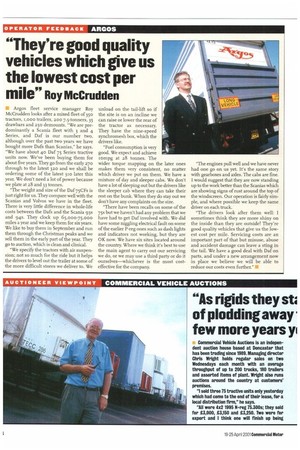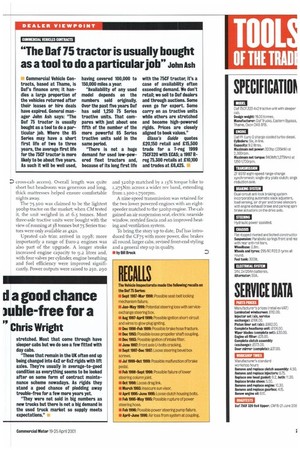"They're good quality vehicles which give us the lowest cost per
Page 26

Page 27

If you've noticed an error in this article please click here to report it so we can fix it.
mile" Roy McCrudden II Argos fleet service manager Roy McCrudden looks after a mixed fleet of 350 tractors, 1,000 trailers, zoo 7.5-tonners, 35 drawbars and 250 demounts. "We are predominantly a Scania fleet with 3 and 4 Series, and Daf is our number two, although over the past two years we have bought more Dafs than Scanias," he says. "We have about 40 Daf 75 Series tractive units now. We've been buying them for about five years. They go from the early 270 through to the latest 320 and we shall be ordering some of the latest 310 later this year. We don't need a lot of power because we plate at 28 and 33 tonnes.
"The weight and size of the Daf 75CFs is just right for us. They compare well with the Scanias and Volvos we have in the fleet. There is very little difference in whole-life costs between the Dafs and the Scania 935 and 94s. They clock up 65,000-75,000 miles a year and we keep them for six years. We like to buy them in September and run them through the Christmas peaks and we sell them in the early part of the year. They go to auction, which is clean and clinical.
"We specify the tractors with air suspension; not so much for the ride but it helps the drivers to level out the trailer at some of the more difficult stores we deliver to. We unload on the tail-lift so if the site is on an incline we can raise or lower the rear of the tractor as necessary. They have the nine-speed synchromesh box, which the drivers like.
"Fuel consumption is very good. We expect and achieve rompg at 28 tonnes. The wider torque mapping on the later ones makes them very consistent, no matter which driver we put on them. We have a mixture of day and sleeper cabs. We don't have a lot of sleeping out but the drivers like the sleeper cab where they can take their rest on the bunk. When they do stay out we don't have any complaints on the size.
"There have been recalls on some of the 75s but we haven't had any problem that we have had to get Daf involved with. We did have some niggling electrical fault on some of the earlier P-reg ones such as dash lights and indicators not working, but they are OK now. We have six sites located around the country. Where we think it's best to use the main agent to carry out our servicing we do, or we may use a third party or do it ourselves—whichever is the most costeffective for the company. "The engines pull well and we have never had one go on us yet. It's the same story with gearboxes and axles. The cabs are fine. I would suggest that they are now standing up to the work better than the Scanias which are showing signs of rust around the top of the windscreen. Our operation is fairly simple, and where possible we keep the same driver on each truck.
"The drivers look after them well: I sometimes think they are more shiny on the inside than they are outside! They're good quality vehicles that give us the lowest cost per mile. Servicing costs are an important part of that but misuse, abuse and accident damage can leave a sting in the tail. We have a good deal with Daf on parts, and under a new arrangement now in place we believe we will be able to reduce our costs even further." M cross-cab access). Overall length was quite short but headroom was generous and long, thick mattresses helped ensure comfortable nights away.
The 75.300 was claimed to be the lightest 300hp tractor on the market; when CM tested it, the unit weighed in at 6.5 tonnes. Most three-axle tractive units were bought with the view of running at 38 tonnes but 75 Series tractors were only available as 4x2s.
Uprated cab trim arrived in 1998; more importantly a range of Euro-2 engines was also part of the upgrade. A longer stroke increased engine capacity to 9.2 litres and, with four valves per cylinder, engine breathing and fuel efficiency were improved significantly. Power outputs were raised to 250, 290 and 32ohp matched by a 13% torque hike to 1,275Nm across a wider rev band, extending from 1,3oo-1,75orpm.
A nine-speed transmission was retained for the two lower powered engines with an eight. speeder matched to the 320hp engine. The cab gained an air suspension seat, electric nearside window, restyled fascia and an improved heating and ventilation system.
To bring the story up to date, Daf has introduced the CF75 with more power, disc brakes all round, larger cabs, revised front-end styling and a general step up in quality.
• by Bill Brock




























































































